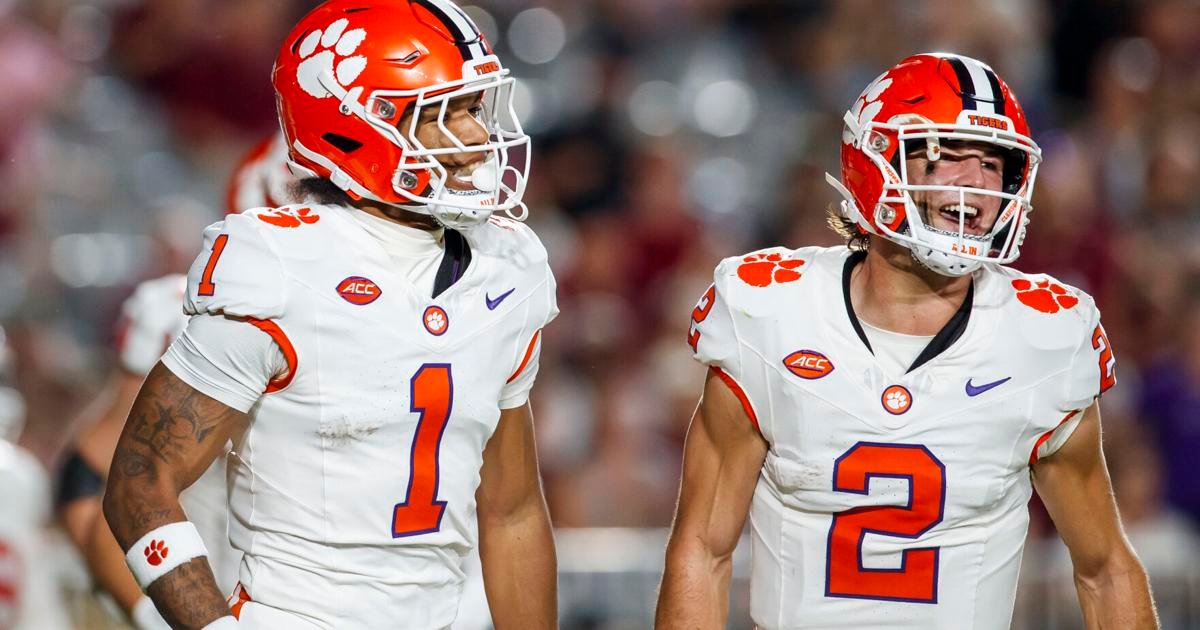CLEMSON — Given the nature of college football recruiting in early 2020, Clemson quarterback Cade Klubnik had a lot of “FaceTimes” with then-offensive coordinator Tony Elliott.
But not much in the way of actual “face time,” and a lowercase “f,” due to restrictions imposed during the COVID-19 pandemic.
“A lot of FaceTimes and a lot of texting,” Klubnik said. “Probably one of the big reasons I came here was because of the guy and the resume and the coach he was — and the person he was and is.”
Clemson’s noon matchup with Virginia on Oct. 19 will provide Klubnik with his first opportunity to shake the hand of a key Tiger recruit, but from the opposing sideline. Because Elliott left for the Cavaliers in December 2021, before Klubnik joined the following January.
Will their first meeting be a little uncomfortable for Elliott, as the young quarterback becomes everything the coach thought he could be? Or will the coordinator who crafted the game plans for Deshaun Watson and Trevor Lawrence somehow find the upper hand in his return to Death Valley?
Here are four things to watch for in a match between (sort of) familiar foes.
Chaos factor
When Dabo Swinney was asked about Virginia quarterback Anthony Colandrea this week, the questioner used the term “chaos factor.”
That was true for the Clemson coach.
“He creates a lot of chaos, that’s for sure,” Swinney said of the sophomore gunslinger.
Colandrea is very willing to keep the ball and rush for long periods of time. Like many of the mobile quarterbacks the Tigers have seen, whether it was Stanford’s Ashton Daniels last month, or Florida State’s Jordan Travis in previous seasons, he can be a major headache.
Will Clemson’s defense bring the discipline needed to quell Virginia’s “chaos factor”? Will the Tigers’ secondary cover last as long as necessary and not allow separation during scramble drills?
“If he comes out of the pocket, you’re four Mississippi, five Mississippi, six Mississippi, seven,” Swinney said.
If Colandrea can’t get to Seven Mississippi, all the better for the Tigers.
Field coverage
Not only does Colandrea have a license to roam, he has a 6-foot-4, 220-pound target in Malachi Fields to throw to.
Fields is one of the most productive receivers in the ACC this season, hauling in 37 catches for 541 yards.
“He’s probably one of the biggest kids we’ll see all year,” Swinney said. “A great and confident player.”
Fortunately, the No. 10 Tigers have a pair of bigger corners in Jaden Locos and Ashton Hampton; They both stand 6-2. Clemson also has one of the biggest corners in college football, 5-11 sophomore Avion Terrell.
“I’ve seen a lot of big players who won’t take on anyone, and I’ve seen some young players who will light you up,” Swinney said. “We’re fortunate to have AV. He has the mentality to do whatever needs to be done in this position.”
It would be interesting to know which angle lines up with the corresponding fields. If it’s Tyrell, will he rise to the occasion, as usual?
Between the goal lines
Virginia and Clemson aren’t afraid to make big plays, whether it’s the Cavaliers pulling off a Philadelphia Eagles-like “push” to pick up a fourth down or the Tigers’ newly unveiled “jumbo” package at the goal line.
It’s not a matter of whether either team will pull these formations as much as it is whether each defense will deny their opponent the opportunity.
Virginia’s offense is getting its share of yards, averaging 435 yards per game. But the Cavaliers — like the Tigers a year ago — are scoring just 27.3 points per game. Elliott’s team is still struggling on third down, with a conversion rate of 35.5 percent.
The Cavaliers have scored the most field goals in the ACC, 12, just one behind the Tigers, who have scored seven in a game at Florida State.
Will Clemson’s defense do enough on downs one and two to ensure Virginia has no chance for a “Brotherly Shove” on fourth down? Will the Tigers’ offense put their FSU red zone struggles in the rearview mirror and finish more drives in the end zone, like they did at Wake Forest?
Better rush defense
One of these defenses allows 4.5 yards per carry.
The other 3.7 per rush.
Few would likely guess that the lower number belongs to Virginia, although Clemson’s statistics are skewed by poor secondary halves by second- and third-rounders in blowouts over App State and NC State.
However, each defense’s success in limiting the other team’s ability to play the ground will likely determine the outcome here. Virginia allows 260 yards per outing through the air, because the Cavaliers’ secondary keeps everything in front of them and forces opponents to string together drives.
Clemson forward Phil Maffah has topped 100 receiving yards in four of his last five games, but has been sluggish at times, early in games. Can he take some big pieces and force Virginia’s defense to deploy more assets against the run?
Another familiar face, former Clemson forward Coby Pace, returns to Death Valley with the Cavaliers. Can the Tigers stuff 5-10, 215 pounds (331 yards) and teammate Xavier Brown (334)?
“I’m looking forward to seeing him, but hopefully he doesn’t have a very good game against the Tigers,” Swinney said of Pace. “Then kill everyone. Run over everyone.”
prediction
Clemson 38, Virginia 17











